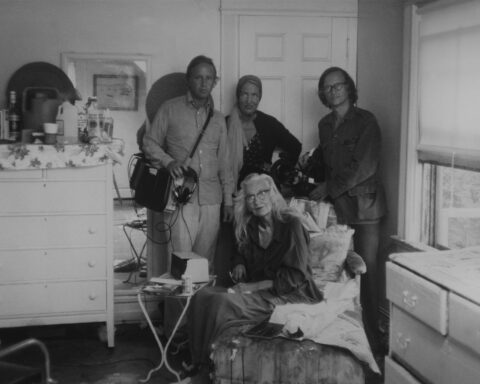One rainy morning in March of 2006, I trudged down to the Varsity in Toronto to see a press screening of an unheralded Canadian film called Six Figures — an assignment that I had accepted grudgingly. For one thing, the film had already been (positively) reviewed by a colleague at Eye Weekly, leading me to wonder why we were not simply repurposing her original review; for another, the dystopian, zeitgeist-baiting action spectacular V for Vendetta was showing just down the hall. As my fellow reviewers mingled in the lobby, laughing excitedly at the prospect of a Wachowski-produced piece of left-wing agitprop—featuring a masked, swashbuckling hero who looked like the Burger King pitchman—I felt a bit like the kid who gets stranded by his older brother and his friends while they go off to do something more fun, than seeing a Canadian first feature by an unheralded filmmaker from, of all places, Alberta.
My disappointment abated approximately two minutes after the lights went down, as Six Figures’ mundane yet foreboding first scene—a pair of prospective homeowners on an open-house visit—gave way to a Hitchcockian credit sequence imbuing the steel-and-glass facades of downtown Calgary with a hard, contemporary anxiety. That same feeling suffuses the remainder of the film, a whodunit with only one real suspect. The audience is fairly certain that the unseen assailant who seriously injures art gallery employee Claire (Caroline Cave) is her perpetually stressed husband Warner (J.R. Bourne), but the emphasis is more on the psychic fallout of the event, diffused across two families with respective histories of violence, than its resolution. The film has the creeping intensity of a top-shelf thriller, even as it bypasses every possible genre convention.
As I left the theatre, I was calling friends to tell them I had seen that rarest of things, a genuinely great Canadian feature. Not to mention the fact that it was a debut. I resolved to meet writer-director David Christensen during his upcoming press day and figure out a) how he had crafted such a sharp, assured film the first time out and, b) why Six Figures hadn’t caused a bigger stir the previous fall during its premiere at the Toronto International Film Festival.
I’m still unclear on b)—not to mention c): why on earth wasn’t Six Figures selected for Canada’s Top Ten? But the answer to a) proved illuminating. Over coffee in downtown Toronto, Christensen told me about the decade he’d spent in television and feature documentary and about his stints programming film series at the Alberta College of Art and Design. Christensen’s affection for exacting, modernist filmmakers like Edward Yang and Michael Haneke helped contextualize Six Figures’ meticulous framing and precise editing rhythms; his documentary background, meanwhile, had clearly informed the film’s numerous patient long takes and impeccable sense of place. By the end of our conversation, I figured that Christensen—a rabid cinephile with a keen compositional eye, a realist’s view of the business and a sincere desire to skirt conventions wherever possible—was set to become a force in the Canadian film landscape.
Two years later, he has, though not in the way that I expected. Last fall, Christensen helped to found the Calgary Cinematheque, which has hosted successful screenings of classic and contemporary art-house films by directors as varied as Max Ophuls, Charles Burnett, and Apichatpong Weerasethakul. Then there was the news of his appointment in October as the Executive Producer of the National Film Board’s North West Centre, a major hire that put this young veteran (Christensen is 42) in a position to help shape new careers. But it also put the issue of his own filmmaking into question.
“There are all sorts of reasons why a person takes a job and gives up something that they’ve been previously doing,” says Christensen in an email exchange from his office in Calgary (for now, he’s still commuting between his hometown and Edmonton). “If picked apart, these reasons might appear very soft, and even naïve. If I said that I took the job because I genuinely wanted to be part of the institution called the National Film Board, with its history and its potential, it does sound terribly naïve.
“And yet,” he continues, “[that nostalgia] was a major factor. Of course, I was interested in the creative direction that I saw the Board going in and I also really wanted to help craft the art of the documentary in Alberta. There are other, less high-falutin’ reasons for taking the job too—there always are. But I would only give up making films to work for the NFB. If it had been any other company or organization, I’d still be an independent filmmaker.”
The director’s personal connection to the NFB dates back to 2003, when it backed his documentary War Hospital, a verité-style look at an international Red Cross facility along the Sudan-Kenya border. “After 3 months in Africa,” says Christensen, “I had 150 hours of footage. I was adamant from the start that the film would not have narration or interviews— or music for that matter—and that meant that we had to work hard to construct a film that relied only on location sound and visuals. I was interested in exploring what it was like to make a film in the direct cinema manner. I’d been hung up on Frederick Wiseman’s films for years and I wanted to see if I could approach, or come within spitting distance of his level of artistry.”
There are indeed passages in War Hospital that approach Wiseman’s observational mastery. The film is at once intimate and unobtrusive, depositing audience members inside a bustling professional space and trusting them to find their bearings. Christensen says that he and his co-director Damien Lewis very nearly capitulated to using a more conventional structure in post-production, but that the space and patience afforded by the Board proved crucial in seeing their original vision through. “The NFB gave us the room and the time to find the film in the edit suite over the course of a year,” he says. “Who else would have been so generous or, depending on how you look at it, so indulgent? If I had had to meet some sort of delivery date, I’d have been sunk. I knew that the Board was one of the few places in Canada that supported this kind of work, and going through the process made me really passionate about the organization.”
Passionate enough that, following Six Figures, Christensen reconnected with his War Hospital producer Bonnie Thompson (a well-established figure at the North West Centre) with the idea of making a film about Alberta’s famed Fort McMurray. Their idea was to use the hybridized doc/fiction techniques of contemporary Iranian cinema to get a new perspective on Canada’s oil sand capital. “Bonnie and I spent some time rhapsodizing about the confluence of drama and documentary in Kiarostami and Makmalbahf,” he recalls. “It hit us that that’s what we wanted to do with the Fort McMurray film—shoot a drama there using people from the community playing characters close to who they were in real life. It was creatively inspiring that the Board would be open to making a documentary this way. And if the Executive Producer job hadn’t come open, I’d probably be making that film right now.”
But he did take the job, which meant that it was now his responsibility to maintain that same inspiring environment for others. “The North West Centre is one of seven English studios across Canada,” explains Christensen when asked to outline the particulars of his position. “Each of them looks after making films in a specific region—in my case, Alberta and the Northwest Territories. We’ve produced or co-produced all sorts of films and have really lead the way when it comes to making films with aboriginal filmmakers about native communities. Part of my job is to ensure that when filmmakers from my region have an idea for a documentary film, they come to the Board to talk to us about it.”
Sometimes, it’s the NFB who does the approaching. One of Christensen’s first projects was a short film about the well- known Alberta-based playwright John Murrell, on the occasion of his receiving a 2008 Governor General’s Performing Arts award. “The challenge is that John is a writer,” says Christensen. “How do you portray what a writer does without falling back on hoary shots of him working at the computer or flipping through books in his library? So much of what a writer does is about imagination. How do you effectively present the process of bringing characters out of one’s mind and into life?”
Christensen and Thompson contacted Calgary director Cam Christiansen, whose fluidly animated music video I Have Seen the Future had been rightly selected as one of Canada’s Top Ten short films for 2007, to see if he could apply a similar aesthetic to the Murrell project. “Cam has a really unique way of animating that combines actual footage of people with an animated world,” says Christensen (who notes that the pair aren’t related—check the spelling of the surnames). “Even though he got about two hours of sleep during the month and a half he had to do the film, he created something utterly unique that gets inside John’s head and portrays his creative process in a totally compelling way.”
The film, entitled The Real Place, will be made available for download from the NFB’s website later in the year, and based on a viewing of the fine cut, the fit between institution and individual was a snug one. It’s a lovely piece of work, with Christiansen’s fluid, layered visuals gliding serenely over Murrell’s modest, engaging narration. “The Board shouldn’t be opaque to the filmmakers we work with,” explains Christensen, stressing his organization’s collaborative mandate. “I explain to them that the Board isn’t a commis- sioning editor or a funder: we’re a creative producer or co-producer who is going to be intimately involved in the making of your film from start to finish. And here are the kind of projects we can be involved in, here’s how that process works, here’s how we’ll help you make a truly distinctive, truly creative film. The absolute last thing I want to make is something that feels familiar, that feels like people have seen it before and forgot [about] it in a hurry.”
Of course, Christensen already succeeded on that count with Six Figures, a film designed to linger in the mind long after its troubling, impenetrable final shot. The problem is that, despite uniformly strong reviews, not a lot of people saw it. Not that Christensen is complaining too loudly. “So many films get made that don’t inspire any sort of response beyond a shrug, and that is the worst sort of response. I knew going into the production of Six Figures that I wasn’t going to make one of those movies. As a filmmaker, I wish more people had seen it, but that isn’t so much a fault of the film as it is the vagaries of making and distributing a Canadian film in Canada.”
Ah, the vagaries of making and distributing a Canadian film in Canada: an issue at once too daunting to be tackled by any one person or group and yet so urgent that anyone working within the industry must feel compelled to at least try. Christensen may not be a pie-eyed optimist—smart people rarely are—but he’s also hesitant to do any doom saying, especially since he’s literally heard it all before. “When I started making documentaries twelve years ago,” he says, “people kept saying that the halcyon days of making docs were over, that the money was tougher to get, international markets weren’t buying, there wasn’t as much room for innovative work anymore and so on. At the time, I had no idea— not a clue—about how to finance a television documentary, and even though people kept telling me how hard it was, I muddled through and got films made, which allowed me to make more films.”
“This is a roundabout way of saying that it’s always possible to characterize the present times as dire when, in fact, one of the big things that has changed is you. The people that were bemoaning the state of Canadian film twelve years ago were my age now, and I know it would be easy for me now to assume that crusty old mantle. Nothing will make me older faster, though. I think if you want to remain responsive and creative and energized about what you do, then it’s always the best time to be making features or documentaries. I’ll certainly be accused of peddling a Panglossian view of the present state of filmmaking in Canada, of course. And I’ll be the first one to admit that, yes, there are setbacks and yes, there are too many philistines out there who refuse to see the merit of this or that project you’re working on. But it will always be so, especially for stuff that is really good. The last thing anyone wants is a bitter filmmaker, though—there’s nothing worse.”
Except maybe a stifled filmmaker. Happily, Christensen has somehow found the time to finish up two non-fiction projects of his own. One is a seven-part series following a class of police recruits during their first year on the beat in Regina—shades, once again of Frederick Wiseman. As for the other project, entitled The Heart of Viganella, it sounds positively Herzogian—or maybe Simpsonian. “It’s about a small remote town in the Italian Alps that, because of the way it is situated in a valley, doesn’t get any sunlight for three months,” Christensen says. “So the community decided to build a 40-square meter mirror and set it up on the mountain behind the village to reflect sunlight onto the square.” He and his stalwart cinematographer Patrick McLaughlin (who also shot Six Figures), have been back to Italy four or five times now, in an extended production period that overlaps with Christensen’s appointment at the NFB. “Luckily, the Board has been very accommodating about my post schedules,” he says. “The amount of work to manage both situations has far exceeded anything that I expected. Let’s just say that it’s been a rather sleepless seven months.”
The next few months sound similarly packed, with Christensen rattling off an impressively variegated list of upcoming projects. “We’ve got Gary Burns’ new documentary in development. We’ve got a long-term web-based project about at-risk youth in production. We’re developing another web-based project about the elderly and the transition from being independent to being dependent. We’re co-producing, with the Montreal animation studio, the new film from Calgary filmmakers Amanda Forbis and Wendy Tilby, who were nominated a few years back for the Short Animation Oscar for When the Day Breaks.” He also cites several up-and- coming Native Canadian filmmakers, including Anne Marie Jackson and Narcise Blood, whose film about Southern Alberta’s Blood Nation will complete a trilogy begun by NFB legend Colin Low with 1960’s Circle of the Sun. “This is the exciting thing about the Board,” says Christensen. “Not only are we finding ways for communities to tell their own stories, but we’ve got this incredibly deep library of films like Circle of the Sun that we can build stories on, and extend their reach into the next century. I mean, cinematically, if it’s done right, imagine the possibilities of integrating and weaving [Colin Low’s] 1960 footage into Narcise’s film. It’ll be wonderful.”









